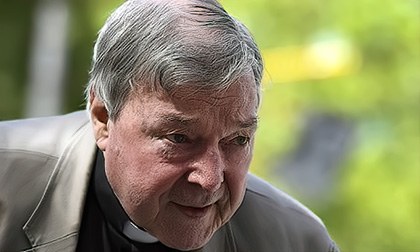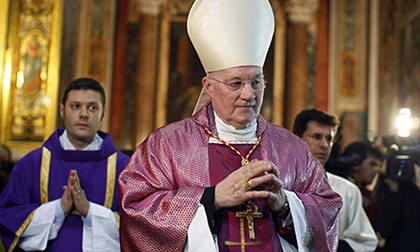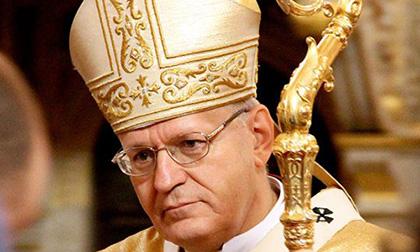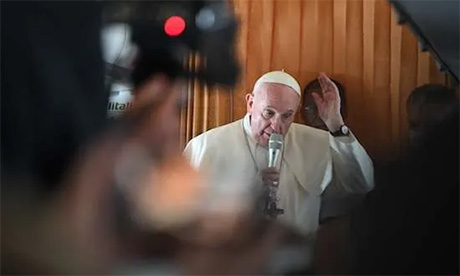Age and illness have not taken the wind out of Pope Francis’ sails.
Despite major intestinal surgery last July and his upcoming 85th birthday in December, the Italo-Argentine pope — amazingly! — is showing absolutely no signs that he’s slowing down or planning to close up shop anytime soon.
His recent four-day visit to Budapest, the capital of Hungary, and then to three cities in neighbouring Slovakia, did nothing to slacken his pace.
Although he looked tired at times during the first day of the September 12-15 trip to Central Europe (he rose around 3:30 in the morning that day), Francis seemed to gain energy as the journey unfolded.
And he resumed his busy schedule of meetings with individuals and groups the very next day after returning to the Vatican.
But the pope is well aware that he has moved into the final and most critical phase of his pontificate, which he has positioned to — among other things — radically transform the governing structures and decision-making mechanisms of the Roman Catholic Church.
“Some wanted me dead”
And he knows there are influential Catholics, and even men in the hierarchy, who would like to see this and other projects brought immediately to a halt.
When a Jesuit confrere in Slovakia asked how he was doing, Francis replied: “Still alive. Despite the fact that some wanted me dead.”
It was a reference to his July operation.
“I know there were meetings among prelates who thought (the pope’s health) was even more serious than was reported. They were preparing the conclave,” the pope said.
Francis then went on to complain about clerics who make “nasty comments” about him and even a large Catholic television network (it seems he meant EWTN) that “badmouths (him) continuously without any qualms”.
It is highly unusual for a pope to openly admit — and lament — that he is facing opposition.
Was Francis conceding that his power to rally the troops has been weakened? Or, rather, was he warning those who are being uncooperative and even adversarial that he has finally lost his patience?
Either way, it looks very much like he’s decided to move into high gear, despite any efforts by opposing forces to derail this final phase of his pontificate.
Things to be done
One of the major projects during his time as pope has been to rewrite the apostolic constitution for the Rome Curia, the Church’s central bureaucracy at the Vatican.
It is said that the document for the “reformed” Curia was completed several months ago and is currently undergoing final corrections, but we still have no idea when it will finally be published.
In all truth, Francis has been implementing reforms, bit-by-bit, all throughout his pontificate by combining or suppressing certain offices, changing a number of protocols and legislation, etc.
He claimed in an interview a couple of months ago that there will be no surprises when the new apostolic constitution is unveiled. But surprises, like beauty, are in the eye of the beholder. There will likely be things that some people will not like at all.
The bigger challenge will be selecting officials who can implement the reform and, more importantly, its guiding vision and ethos. Francis has to make numerous key personnel changes, especially to replace several cardinals in major Vatican posts who are already past the normal retirement age of 75.
The Jesuit pope has habitually by-passed the Roman Curia during much of his pontificate and has increasingly said and done things to “smoke out” those who are not in line with his policies.
He’s provoked reactions in a way that has forced bishops and cardinals to show their true colours and reveal where they really stand on disputed issues.
And he’s operated in unconventional ways — like ordering apostolic visitations of Curia offices — that keep those who work in the Vatican “guessing” or “off-balance”.
It’s not only possible, but also probable, that rumours of the pope’s ill-health were spread by Francis himself!
As the first pope since Pius X (over a hundred years ago) who never studied or worked in Rome, Francis is an outsider. And he’s had to move creatively and strategically to outmanoeuvre the Curia forces.
One of the keys to this has been his deliberate moves to de-mythologize the papacy, mainly by speaking and acting as if he were just any other bishop and by conducting many of his affairs in a non-institutional way.
Obviously, this has infuriated many in the Vatican and in the hierarchy.
Will he ever resign?
There is no question that Francis would like to see it become quite normal for the Bishop of Rome to have the option to freely resign his office, rather than maintaining papal resignations as something extraordinary that happen only once every four- or five-hundred years.
As a Jesuit, he knows better than any that normalizing resignation from a once considered a lifetime office can more easily gain traction when consecutive office holders step down.
The late Peter-Hans Kolvenbach was the Jesuits’ first-ever Father General to resign voluntarily from his lifetime post. But it was not easy.
John Paul II refused to allow him to retire. Kolvenbach had to wait until after Benedict XVI was elected pope to finally be able to resign. He and Benedict agreed in 2006 that the Dutch Jesuit would step down two years later upon his 80th birthday.
Kolvenbach’s successor, Adolfo Nicolás, resigned in 2016, also when he turned 80 years of age. And it is expected that the man who replaced him and is the current Father General will also resign one day, rather than remain in office for life.
It seems clear that Francis would like to see a similar situation happen with the papacy — in an ideal world. But things are far from ideal right now and much depends on the circumstances.
It is said that it would be unwise to have two retired popes who are still alive. But if Francis were to feel he is unable to fulfill his duties as pope, he probably would not hesitate to step down, even if Benedict were still alive.
However, if Benedict dies before he does, the current pope could decide to resign precisely in order to “normalize” papal resignations.
Take a good look at the 38 electors who got their red hats from Benedict and see if you’d be excited if any of them were to succeed Pope Francis.
What about the opposition?
Some Italian reports, following up on Francis’ comments to the Jesuits in Slovakia, say there are four or five cardinals and bishops — all members of the Roman Curia and mostly non-Italians — who have already begun strategizing for the next conclave.

Cardinal George Pell
One person to keep an eye on is Australian Cardinal George Pell, the man who backed Angelo Scola in the 2013 conclave that elected Francis.
Pell turned 80 in June and is ineligible to vote for the next pope, but he can do a lot of politicking for the forces inside the College of Cardinals who want to reverse (or severely alter) the direction in which Francis is steering the Barque of Peter.
Pell, the Vatican’s former financial czar, returned to Australia in 2017 to be tried on historic sex abuse charges. He was convicted and jailed for just over a year, but then the sentence was reversed in April 2020.
At the time, the cardinal said he would go to Rome to clean out his apartment but planned on returning to Sydney for good. He arrived in the Eternal City exactly one year ago — in September 2020 — and he has never left.
And the only way he’ll likely go back to Australia before the next conclave is in a box. Because he and others who are not fans of Francis want to be part of the conversation and politics leading up to the next papal election.

Cardinal Marc Ouellet
The strongest candidate in the anti-Francis camp still appears to be Cardinal Marc Ouellet, 77, who has been head of the powerful Congregation for Bishops the past 11 years. He’s carefully downplayed and even hidden his more traditionalist views, which line up almost identically with those of Benedict XVI.
Surely, enough of the cardinal-electors will see through this, right? Don’t be so sure. Many of them are from far-flung places. They are not theological heavy-hitters or very fluent in the language of Vatican politics.

Cardinal Péter Erdő
Another candidate of the anti-Francis bloc is Hungarian Cardinal Péter Erdő. He got his red hat in 2003 at the same consistory at which Pell, Scola and Ouellet also became cardinals.
The 69-year-old canon lawyer speaks Italian flawlessly and is also conversant in German, French and Spanish. He is a former two-term president of the Council of the Episcopal Conferences of Europe (CCEE), which consists of the heads of all national bishops’ conferences on the Old Continent.
Erdő has carefully cultivated friendships and alliances in the College of Cardinals and is expected to be a major player at the next conclave, either as a candidate or kingmaker. He won praise for being a gracious host at the International Eucharistic Congress earlier this month in Budapest.
No fewer than 11 voting-age cardinals attended the all-expenses-paid weeklong congress. Even prelates who do not share all of the Hungarian cardinal’s theological perspectives came away with a much more favorable impression of him.
Do the pope’s allies have a strategy?
Francis has named 70 of the current 121 cardinal-electors. And he’s sure to name more, perhaps as early as November, just to keep the slots filled over the next several months.
If there is a consistory in a couple of months from now, the pope will probably create only five to seven new cardinals. That will keep the number of electors hovering just over the 120 limit that Paul VI set. That is an arbitrary limit, actually, that the pope has absolute freedom to exceed at any moment.
John Paul II twice pushed the number to 135 and Benedict XVI once expanded it to 125.
Five of the current electors age out between now and next June, but three of them are cardinals that Francis named; the other two got their red hats from John Paul.
Six more reach the age of 80 between June 2022 and the end of that year. Only one of them was named by Francis, but four were created by Benedict.
Therefore, barring any deaths among the body of electors, the Jesuit pope’s cardinals could, by the end of 2020, constitute well over the required 2/3 majority needed to choose his successor.
Will the next pope continue Francis’ vision?
Fans of the current pope’s style and course of action should thank God that Benedict XVI was elected in 2005.
Because it is very likely that if Jorge Mario Bergoglio from Argentina had been chosen at that conclave, he would have been a much different pope than the one he is today.
Without Benedict there is no Francis.
We cannot know for sure what kind of pontificate Bergoglio would have had as the immediate successor of John Paul II. But it probably would have looked somewhat different from the one we’ve been experiencing since 2013.
The current pope reportedly told a fellow cardinal after the 2005 conclave that he probably would have called himself John XXIV had the votes gone to him instead of Benedict.
But would he have been ready — would the Church have been ready — back then for the reforms and change of ethos he has championed as Pope Francis?
We do not know. And neither do we know if the man who succeeds him will carry the reforming spirit forward.
There are simply no guarantees.
Even if Francis stacks the College of Cardinals with supporters, there is no way he or anyone else can ensure that one of his men will get elected.
Think about this: John Paul’s successor (Benedict) got his red hat from Paul VI. And Benedict’s successor (Francis) got his from John Paul.
Take a good look at the 38 electors who got their red hats from Benedict and see if you’d be excited if any of them were to succeed Pope Francis.
- Robert Mickens is LCI Editor in Chief.
- First published in La-Croix International. Republished with permission.
News category: Analysis and Comment.




